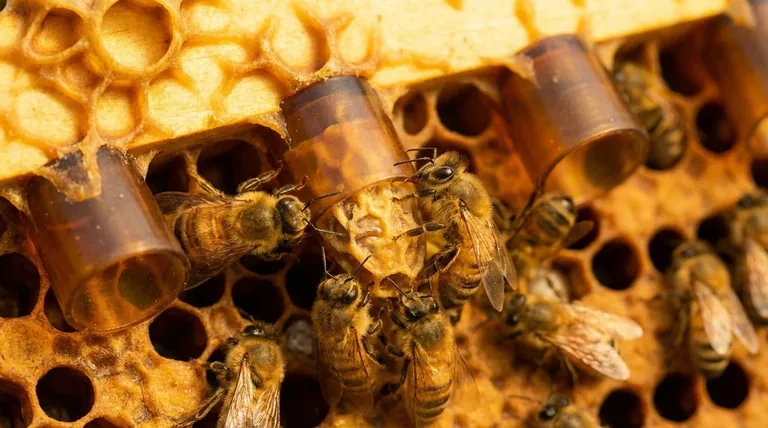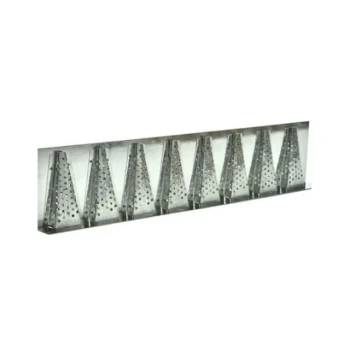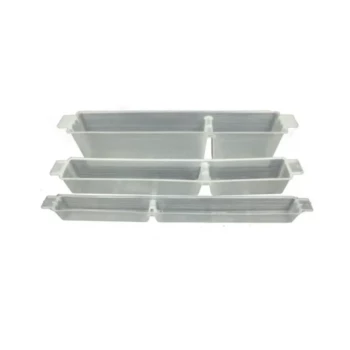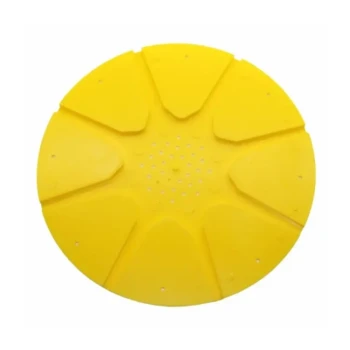At its core, a queen cell protector is a physical shield for a developing queen. It is a cone-shaped, spiral wire cage that fits securely over a delicate queen cell. Its primary function is to protect this vulnerable cell from being destroyed by worker bees when it is introduced into a new, queenless colony.
The central challenge in beekeeping is ensuring a new queen is accepted by a colony. The queen cell protector is a critical tool that solves this by physically guarding the developing queen while allowing her pheromones to acclimate the hive, dramatically increasing the odds of a successful introduction.

The Core Problem: Why Queen Cells Are Vulnerable
Introducing a new queen, even one still developing in her cell, is a delicate operation. The existing bees in a colony are programmed to see any unfamiliar queen as a threat to their hive's genetic line and stability.
The Instinct to Destroy Rivals
Worker bees are fiercely loyal to their current queen or, if queenless, are in the process of raising their own. An introduced queen cell is perceived as an intruder. The workers' primary instinct is to "ball" the cell—surrounding and tearing it down to eliminate the potential rival.
The Threat of Foreign Pheromones
A queen cell contains a developing pupa that already emits subtle queen pheromones. These scents are foreign to the new colony, triggering aggressive and defensive behavior from the resident worker bees who are accustomed to the scent of their old queen.
How the Protector Solves the Problem
The queen cell protector's simple design directly counteracts these threats, acting as a crucial intermediary during the introduction process.
Providing Physical Protection
The wound wire construction creates a sturdy physical barrier. This cage prevents worker bees from accessing the delicate wax cell to chew through it or sting the developing pupa inside.
Allowing Pheromonal Acclimation
The open, spiral design is not a solid wall. It allows air to circulate freely around the queen cell. This is essential for dispersing the new queen's pheromones throughout the colony, allowing the worker bees to gradually acclimate to her scent before she emerges.
Ensuring a Safe Emergence
The protector is designed with an open tip. This allows the virgin queen to emerge from her cell unhindered once she is fully developed. However, the cage remains in place, continuing to protect her during the first critical hours of her life within the new hive.
Understanding the Key Trade-off
While highly effective, using a queen cell protector is not an absolute guarantee of success. It is a tool that manages risk, but the beekeeper's timing and assessment remain critical.
Protection Is Not a Guarantee of Acceptance
The protector's main function is to prevent premature destruction of the cell. It does not force acceptance of the new queen after she emerges. If the colony is not truly queenless or has other issues, they may still reject the virgin queen once she leaves the safety of the protector.
Risk of Damage During Installation
Queen cells are extremely fragile. The process of handling the cell and fitting the protector requires a gentle hand. Pressing too hard or clumsy handling can easily crush the cell, killing the developing queen before the process even begins.
How to Apply This to Your Beekeeping
Using a queen cell protector is a standard practice in specific beekeeping scenarios. Its use is directly tied to the goal of introducing new genetics or establishing new colonies efficiently.
- If your primary focus is creating splits or nucs: Use a protector to safely introduce a purchased or grafted queen cell, which is faster and more reliable than letting the new colony raise its own emergency queen.
- If your primary focus is requeening an existing colony: The protector is essential to give your new, high-quality queen cell the best possible chance of survival and acceptance by the established workforce.
- If your primary focus is queen rearing: Protectors are non-negotiable for safely moving your valuable grafted cells from a cell-builder colony into individual mating nucs.
Ultimately, this simple wire cone is an indispensable tool that empowers you to manage your colony's genetics with greater confidence and success.
Summary Table:
| Aspect | Function |
|---|---|
| Primary Role | Physical shield for a developing queen cell |
| Key Benefit | Prevents worker bees from destroying the cell |
| Design Feature | Spiral wire cage allowing pheromone dispersal |
| Best For | Introducing new queens, requeening, creating splits/nucs |
Ready to boost your queen introduction success rates?
For commercial apiaries and beekeeping equipment distributors, a reliable supply of high-quality queen cell protectors is key to efficient colony management. HONESTBEE supplies the durable beekeeping equipment you need to protect your valuable genetics and ensure smooth hive operations.
Contact HONESTBEE today to discuss your wholesale needs and secure your essential beekeeping supplies.
Visual Guide

Related Products
- Brown Nicot Queen Cell Cups for Breeding Queen Bees Beekeeping
- JZBZ Push-In Queen Cell Cups for Beekeeping
- Plastic Beekeeping Honey Bee Larvae Grafting Tools for Queen Rearing and Chinese Grafting
- Wooden Queen Bee Excluder for Beekeeping
- Plastic Queen Bee Excluder for Bee Hive Wholesale
People Also Ask
- What are the ideal conditions for raising good queen cells? Achieve Robust Queens with Strong Cell-Builder Colonies
- What is the advantage of the Nicot Cupkit system? Secure Your Queen Rearing Success with Batch Protection
- What are the signs that a queen cell is about to emerge? Master the Critical Timing for Hive Success
- What role does the natural swarming process play in queen rearing? Harness the Swarm Instinct for Better Queens
- How are the queen cells raised after removing the plugs? Master the Art of Queen Rearing



















